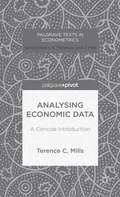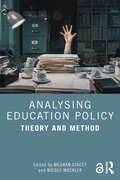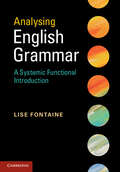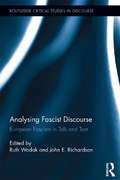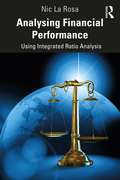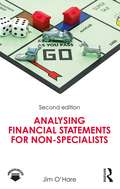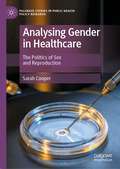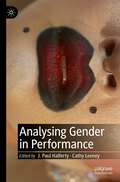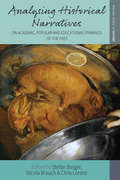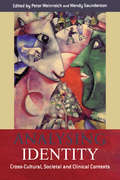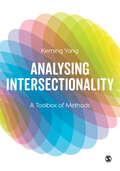- Table View
- List View
Analysing Economic Data: A Concise Introduction (Palgrave Texts in Econometrics)
by Terence C. MillsCovers the key issues required for students wishing to understand and analyse the core empirical issues in economics. It focuses on descriptive statistics, probability concepts and basic econometric techniques and has an accompanying website that contains all the data used in the examples and provides exercises for undertaking original research.
Analysing Education Policy: Theory and Method
by Nicole Mockler Meghan StaceyAnalysing Education Policy: Theory and Method provides a comprehensive overview of key approaches in critical education policy research. With chapters from internationally recognised and established scholars in the field, this book provides an authoritative account of how different questions may be approached and answered. Part 1 features chapters focused on text-based approaches to analysis, including critical discourse analysis, thinking with Foucault, Indigenist Policy Analysis, media analysis, the analysis of promotional texts in education, and the analysis of online networks. Part 2 features chapters focused on network ethnography, actor-network theory, materiality in policy, Institutional Ethnography, decolonising approaches to curriculum policy, working with children and young people, and working with education policy elites. These chapters are supported by an introduction to each section, as well as an overall introduction and conclusion chapter from the editors, drawing together key themes and ongoing considerations for the field. Critical education policy analysis takes many different forms, each of which works with distinctly different questions and fulfils different purposes. This book is the first to clearly map current common and influential approaches to answering these questions, providing important guidance for both new and established researchers.
Analysing Education Policy: Theory and Method
by Nicole Mockler Meghan StaceyAnalysing Education Policy: Theory and Method provides a comprehensive overview of key approaches in critical education policy research. With chapters from internationally recognised and established scholars in the field, this book provides an authoritative account of how different questions may be approached and answered.Part 1 features chapters focused on text-based approaches to analysis, including critical discourse analysis, thinking with Foucault, Indigenist Policy Analysis, media analysis, the analysis of promotional texts in education, and the analysis of online networks. Part 2 features chapters focused on network ethnography, actor-network theory, materiality in policy, Institutional Ethnography, decolonising approaches to curriculum policy, working with children and young people, and working with education policy elites. These chapters are supported by an introduction to each section, as well as an overall introduction and conclusion chapter from the editors, drawing together key themes and ongoing considerations for the field.Critical education policy analysis takes many different forms, each of which works with distinctly different questions and fulfils different purposes. This book is the first to clearly map current common and influential approaches to answering these questions, providing important guidance for both new and established researchers.The Open Access version of this book, available at http://www.taylorfrancis.com, has been made available under a Creative Commons Attribution-Non Commercial-No Derivatives (CC-BY-NC-ND) 4.0 license.
Analysing English Grammar
by Lise FontaineA practical step-by-step introduction to the analysis of English grammar, this book leaves the reader confident to tackle the challenges analysing grammar may pose. The first textbook to take an integrated approach to function and structure in grammatical analysis, it allows students to build experience, skills and confidence in working with grammar. The innovative, hybrid approach combines an introduction to systemic functional theory with a solid grounding in grammatical structure. The book approaches grammar in an incremental way, enabling students to develop grammatical skill in stages. It is of particular value to those starting to work with functional grammar but it is also relevant for experienced readers who are interested in developing a more systematic approach to grammatical analysis.
Analysing English-Arabic Machine Translation: Google Translate, Microsoft Translator and Sakhr (Routledge Studies in Translation Technology)
by Zakaryia AlmahaseesMachine Translation (MT) has become widely used throughout the world as a medium of communication between those who live in different countries and speak different languages. However, translation between distant languages constitutes a challenge for machines. Therefore, translation evaluation is poised to play a significant role in the process of designing and developing effective MT systems. This book evaluates three prominent MT systems, including Google Translate, Microsoft Translator, and Sakhr, each of which provides translation between English and Arabic. In the book Almahasees scrutinizes the capacity of the three systems in dealing with translation between English and Arabic in a large corpus taken from various domains, including the United Nation (UN), the World Health Organization (WHO), the Arab League, Petra News Agency reports, and two literary texts: The Old Man and the Sea and The Prophet. The evaluation covers holistic analysis to assess the output of the three systems in terms of Translation Automation User Society (TAUS) adequacy and fluency scales. The text also looks at error analysis to evaluate the systems’ output in terms of orthography, lexis, grammar, and semantics at the entire-text level and in terms of lexis, grammar, and semantics at the collocation level. The research findings contained within this volume provide important feedback about the capabilities of the three MT systems with respect to EnglishArabic translation and paves the way for further research on such an important topic. This book will be of interest to scholars and students of translation studies and translation technology.
Analysing Erasmus+ Vocational Education and Training Funding in Europe (Technical and Vocational Education and Training: Issues, Concerns and Prospects #30)
by Carlos de Olagüe-SmithsonThis volume presents an analysis of the Erasmus+ funding process. It examines the first 3 years of the programme to discover if the funds are being distributed homogeneously throughout the regions of France, Germany, Italy, Spain and the United Kingdom. If it turns out that funds are being unevenly delivered this could result in an inequity situation: students living in specific regions might have greater chances to benefit from KA102 funds, while other students might have fewer opportunities to benefit from these funds. The book looks in detail at the implementation and performance of the various programmes within Erasmus+, the funds and distribution of these funds, and the number of students in the programmes. The book studies these five countries because they contain more than half of all the vocational education and training students in the European Union. Also, these countries had the most students participating in mobilities during the previous Leonardo da Vinci programme. Hence, it is to be expected that the conclusions drawn in this study are representative of the situation of VET mobilities and Erasmus+ funding in Europe. Erasmus+ is the European programme in charge of fostering the development of transnational programmes in the areas of education, training, sports and youth policies. It is focused on the adaptation to a fast changing world, tackling youth unemployment, and preparing workers for highly skilled jobs. Erasmus+ integrates former programmes such as the Lifelong Learning Programme, Youth in Action, and the various international Higher Education and Sports programmes. It started in 2014 and will be active until 2020.
Analysing Families: Morality and Rationality in Policy and Practice
by Rosalind Edwards Alan Carling Simon DuncanWhile the family and its role continues to be a key topic in social and government policy, much of the literature is concerned with describing the dramatic changes that are taking place. By contrast, Analysing Families directly addresses the social processes responsible for these changes - how social policy interacts with what families actually do. Topics covered include:* the relationship between morality and rationality in the family context* the variety of contemporary family forms* the purposes and assumptions of government interventions in family life* the relationship between different welfare states and different ideas about motherhood* 'Third Way' thinking on families* divorce and post-divorce arrangements* lone parenthood and step-parenting* the decision to have children* the economic approach to understanding family process* the legitimacy of state intervention in family life.With contributions from the UK, and North America, Analysing Families provides the framework within which to understand an increasingly important element in social policy.
Analysing Fascist Discourse: European Fascism in Talk and Text (Routledge Critical Studies in Discourse #5)
by Ruth Wodak John E. RichardsonThis book focuses primarily on continuities and discontinuities of fascist politics as manifested in discourses of post-war European countries. Many traumatic pasts in Europe are linked to the experience of fascist and national-socialist regimes in the 20th century and to related colonial and imperialist expansionist politics. And yet we are again confronted with the emergence, rise and success of extreme right wing political movements, across Europe and beyond, which frequently draw on fascist and national-socialist ideologies, themes, idioms, arguments and lexical items. Post-war taboos have forced such parties, politicians and their electorate to frequently code their exclusionary fascist rhetoric. This collection shows that an interdisciplinary critical approach to fascist text and talk—subsuming all instances of meaning-making (oral, visual, written, sounds, etc.) and genres such as policy documents, speeches, school books, media reporting, posters, songs, logos and other symbols—is necessary to deconstruct exclusionary meanings and to confront their inegalitarian political projects.
Analysing Financial Performance: Using Integrated Ratio Analysis
by Nic La RosaDespite a plethora of techniques to analyse the financial performance of a business, there has been no single methodology that has been overwhelmingly preferred by users. This could be an indication that either the methods themselves are deficient or they are limited by other factors that are not easily overcome. Unlike the current offerings in the field, which focus on issues relating to business performance management or non-financial aspects (such as market efficiency, satisfaction and workforce productivity), this book offers a solution to a major gap in the literature and understanding for those seeking to measure, analyse and benchmark the financial performance of any organisation (for-profit, not-for-profit and government agencies). It clearly identifies why current techniques fail; proposes and evidences a solution that overcomes these issues by including two algorithms that can be combined, to solve this problem; and demonstrates the practical application of the technique to the benefit of users in order to pinpoint real performance levels and insights. One of the largest issues this book will help to overcome is the inability to compare the accounts of businesses/organisations from different countries that report in different currencies. This technique eliminates the need for currency translations and the issues that arise with that process. This book is an invaluable and practical guide to assist accounting and finance practitioners in measuring and comparing financial performance across firms with different business models, different accounting policies and different scales of operations.
Analysing Financial Statements for Non-Specialists
by Jim O'HareAll business organizations produce financial statements, and the information communicated (or hidden) in these is relevant to a wide range of users. After a number of recent financial scandals from banks to supermarkets, the need to fully understand financial statements has never been so imperative, and the topic itself so pertinent. With updated examples to reflect the current business environment, including new material on the ethical considerations, and a wider array of business examples, from retail to services and banks, O’Hare continues to demist financial statements for non-specialists. In this new and refreshed edition, he once again covers the topic in an accessible way and assumes no prior training or study in accounting. Offering a range of extra resources, including end of chapter questions, topics for further discussion and brimming with real-world examples, this concise new edition provides a comprehensive resource that will be welcomed by lecturers and instructors charged with delivering classes on financial statements.
Analysing Gender in Healthcare: The Politics of Sex and Reproduction (Palgrave Studies in Public Health Policy Research)
by Sarah CooperThis book explores regulatory conundrums around adolescent sexual health, abortion and assisted reproductive technologies in the UK. In doing so, it seeks to examine the various stages at which women’s reproductive health comes into contact with government action and assesses how these legal and policy fields are shaped through the conceptual lens of policy networks. Transformed expectations of women’s roles, along with developed biological capabilities and understandings of gender and sexuality have driven an increasingly complex politics of sex and reproduction. The book argues that assumed medial control over these issues is overshadowed by government calculations of cost-effectiveness. Moreover, decisions on the design of programmes and levels of access continually reflect traditional family formation. The outcome is unsurprisingly the marginalisation of women in publicly funded healthcare, but with a clear further impact on gender and sex minorities. COVID-19 has disrupted these dynamics further, altering the manner in which previously inhibited patients engage with the NHS. As the pandemic recedes it has become more timely than ever to consider the future of gendered healthcare in the UK, and to question the likelihood of long term change in the ability of patients to inform health policy decisions. The book will appeal to scholars and students of gender and health policy, law and politics, as well as healthcare practitioners.
Analysing Gender in Performance
by J. Paul Halferty Cathy LeeneyAnalysing Gender in Performance brings together the fields of Gender Studies and Performance Analysis to explore how contemporary performance represents and interrogates gender. This edited collection includes a wide range of scholarly essays, as well as artists’ voices and their accounts of their works and practices. The Introduction outlines the book’s key approaches to concepts in English language gender discourses and gender’s intersectionalities, and sets out the approaches to performance analysis and methods of research employed by the various contributors. The book focuses on performances from the Global North, staged over the past fifty years. Case studies are diverse, ranging from site-specific, dance theatre, speculative drag, installation, and music video performances to Mabou Mines, Churchill, Shakespeare and Ibsen. Contributors explore how gender intersects with sexuality, social class, race, ethnicity, indigeneity, culture and history. Read individually or in tension with one another, the essays confront the contemporary complexities of analysing gender in performance.
Analysing Genre: Language Use in Professional Settings (Applied Linguistics and Language Study)
by V. K. BhatiaGenre analysis has a long-established tradition in literature, but interest in the analysis of non-literary genres has been very recent. This book examines the theory of genre analysis, looks at genre analysis in action, taking texts from a wide variety of genres and discusses the use of genre analysis in language teaching and language reform.
Analysing Health Care Organizations: A Personal Anthology (Routledge Studies in Health Management)
by Ewan FerlieAnalysing Health Care Organizations seeks to link the world of health policy and management with the academic field of organization studies in a novel and additive way. It outlines the main developments in UK health care management apparent over the last thirty years and explores how they might be (re)seen with the application of some important organizational theories and perspectives. This book draws out contemporary and enduring themes from current literature on health care organization and considers them from a range of theoretical perspectives. Drawing on robust areas of research and some key academics who contribute to work in this field, it is a book relevant both to experts in the field and to those seeking to develop an understanding of health care organization from a theoretical perspective. Analysing Health Care Organizations provides a state of the art introduction foundation for subsequent works that will extend its content; providing a broad introductory overview of this theoretical terrain and setting the scene for further research.
Analysing Health Communication: Discourse Approaches
by Gavin Brookes Daniel HuntThis edited book showcases original research in the study of healthcare and health communication, while also providing a detailed overview of contemporary methods of discourse analysis. Discourse approaches remain under-represented in the field of health communication, despite their potential for affording detailed understanding of health-related text and talk across an array of contexts, for example in face-to-face and digital healthcare encounters, health promotion, and patients’ accounts of illness experiences. This book aims to address this gap in the literature by offering the first book-length treatment of different approaches to discourse analysis in health(care) and illness contexts, and it will appeal both to linguists and to researchers in nursing and health sciences, sociology and anthropology.
Analysing Historical Mathematics Textbooks (International Studies in the History of Mathematics and its Teaching)
by Gert SchubringThis book is about the creation and production of textbooks for learning and teaching mathematics. It covers a period from Antiquity to Modern Times. The analysis begins by assessing principal cultures with a practice of mathematics. The tension between the role of the teacher and his oral mode, on the one hand, and the use of a written (printed) text, in their respective relation with the student, is one of the dimensions of the comparative analysis, conceived of as the ‘textbook triangle’. The changes in this tension with the introduction of the printing press are discussed. The book presents various national case studies (France, Germany, Italy) as well as analyses of the internationalisation of textbooks via transmission processes. As this topic has not been sufficiently explored in the literature, it will be very well received by scholars of mathematics education, mathematics teacher educators and anyone with an interest in the field.
Analysing Historical Narratives: On Academic, Popular and Educational Framings of the Past (Making Sense of History #40)
by Chris Lorenz Stefan Berger, Nicola BrauchFor all of the recent debates over the methods and theoretical underpinnings of the historical profession, scholars and laypeople alike still frequently think of history in terms of storytelling. Accordingly, historians and theorists have devoted much attention to how historical narratives work, illuminating the ways they can bind together events, shape an argument and lend support to ideology. From ancient Greece to modern-day bestsellers, the studies gathered here offer a wide-ranging analysis of the textual strategies used by historians. They show how in spite of the pursuit of truth and objectivity, the ways in which historians tell their stories are inevitably conditioned by their discursive contexts.
Analysing Historical Narratives: On Academic, Popular and Educational Framings of the Past (Making Sense of History #40)
by Chris Lorenz Stefan Berger, Nicola BrauchFor all of the recent debates over the methods and theoretical underpinnings of the historical profession, scholars and laypeople alike still frequently think of history in terms of storytelling. Accordingly, historians and theorists have devoted much attention to how historical narratives work, illuminating the ways they can bind together events, shape an argument and lend support to ideology. From ancient Greece to modern-day bestsellers, the studies gathered here offer a wide-ranging analysis of the textual strategies used by historians. They show how in spite of the pursuit of truth and objectivity, the ways in which historians tell their stories are inevitably conditioned by their discursive contexts.
Analysing Identity: Cross-Cultural, Societal and Clinical Contexts
by Peter Weinreich Wendy SaundersonPeople's identities are addressed and brought into being by interaction with others. Identity processes encompass biographical experiences, historical eras and cultural norms in which the self's autonomy varies according to the flux of power relationships with others. Identity Structure Analysis (ISA) draws upon psychological, sociological and social anthropological theory and evidence to formulate a system of concepts that help explain the notion of identity. They can be applied to the practical investigations of identity structure and identity development in a number of clinical, societal and cultural settings. This book includes topics on national and ethnic identification in multicultural contexts and gender identity relating to social context and the urban environment. Clinical applications that describe identity processes associated with psychological distress are also examined. These include anorexia nervosa and vicarious traumatisation of counsellors in the aftermath of atrocity. Analysing Identity is unique in its development of this integrative conceptualisation of self and identity, and its operationalisation in practice. This innovative book will appeal to academics and professionals in developmental, social, cross-cultural, clinical and educational psychology and psychotherapy. It will also be of interest to those involved with sociology, political science, gender studies, ethnic studies and social policy. Of particular note is the availability of new software, Ipseus, which facilitates ISA for use by practitioners. It enables them to enhance their professional skills by ascertaining their clients’ perspectives on self as located in the social world. This has been successfully used with pre-school three to five year-old children, and all other age-ranges through childhood, adolescence and adulthood. Ipseus is designed to be used in inter-cultural contexts and appeals to practitioners for their input for the generation of customized identity instruments (see www.identityexploration.com).
Analysing Inequalities in Germany: A Structured Additive Distributional Regression Approach (SpringerBriefs in Statistics)
by Alexander SilbersdorffThis book seeks new perspectives on the growing inequalities that our societies face, putting forward Structured Additive Distributional Regression as a means of statistical analysis that circumvents the common problem of analytical reduction to simple point estimators. This new approach allows the observed discrepancy between the individuals' realities and the abstract representation of those realities to be explicitly taken into consideration using the arithmetic mean alone. In turn, the method is applied to the question of economic inequality in Germany.
Analysing Intersectionality: A Toolbox of Methods
by Keming YangHow can we analyse the intersectional effects of multiple factors on experiences of disenfranchisement? This book equips you with the methodological tools to uncover new insights. First providing a critical examination of long-standing methodologies in intersectionality research, it then shines a spotlight on analytical techniques such as qualitative comparative analysis, multilevel models, mediation and moderation, and mixed methods designs. With chapter objectives, real-world research examples, further reading and reflective questions, it will equip you with the methodological tools to understand intersectionality in specific social settings. The book: · Bridges the gap between intersectionality as a theory and an empirical research practice. · Extends existing approaches to analysing intersectionality in a traditionally qualitative field. · Inspires creativity and celebrates a variety of effective methods for studying intersectionality. Innovative and thought-provoking, this book is ideal for any student or researcher looking to harness the power of empirical evidence to explore inequality and injustice.
Analysing Intersectionality: A Toolbox of Methods
by Keming YangHow can we analyse the intersectional effects of multiple factors on experiences of disenfranchisement? This book equips you with the methodological tools to uncover new insights. First providing a critical examination of long-standing methodologies in intersectionality research, it then shines a spotlight on analytical techniques such as qualitative comparative analysis, multilevel models, mediation and moderation, and mixed methods designs. With chapter objectives, real-world research examples, further reading and reflective questions, it will equip you with the methodological tools to understand intersectionality in specific social settings. The book: · Bridges the gap between intersectionality as a theory and an empirical research practice. · Extends existing approaches to analysing intersectionality in a traditionally qualitative field. · Inspires creativity and celebrates a variety of effective methods for studying intersectionality. Innovative and thought-provoking, this book is ideal for any student or researcher looking to harness the power of empirical evidence to explore inequality and injustice.
Analysing Intraday Implied Volatility for Pricing Currency Options (Contributions to Finance and Accounting)
by Thi LeThis book focuses on the impact of high-frequency data in forecasting market volatility and options price. New technologies have created opportunities to obtain better, faster, and more efficient datasets to explore financial market phenomena at the most acceptable data levels. It provides reliable intraday data supporting financial investment decisions across different assets classes and instruments consisting of commodities, derivatives, equities, fixed income and foreign exchange. This book emphasises four key areas, (1) estimating intraday implied volatility using ultra-high frequency (5-minutes frequency) currency options to capture traders' trading behaviour, (2) computing realised volatility based on 5-minute frequency currency price to obtain speculators' speculation attitude, (3) examining the ability of implied volatility to subsume market information through forecasting realised volatility and (4) evaluating the predictive power of implied volatility for pricing currency options. This is a must-read for academics and professionals who want to improve their skills and outcomes in trading options.
Analysing Kazakhstan's Foreign Policy: Regime neo-Eurasianism in the Nazarbaev era (Central Asia Research Forum)
by Luca AnceschiThis book investigates the roles that ideas and constructs associated with Eurasia have played in the making of Kazakhstan’s foreign policy during the Nazarbaev era. This book delves into the specific Eurasia-centric narratives through which the regime, headed by Nursultan Nazarbaev, imagined the role of post-Soviet Kazakhstan in the wider Eurasian geopolitical space. Based on substantive fieldwork and sustained engagement with primary sources, the book unveils the power implications of Kazakhstani neo-Eurasianism, arguing that the strengthening of the regime’s domestic power ranked highly in the list of objectives pursued by Kazakhstani foreign policy between the collapse of the Soviet Union and Nazarbaev’s apparent withdrawal from the Kazakhstani political scene (19 March 2019). This book, ultimately, is a study of inter-state integration, which makes use of a rigorous methodological approach to assess different incarnations of post-Soviet multilateralism, from the Commonwealth of Independent States to the more recent, and highly controversial, Eurasian Economic Union. This book offers a ground-breaking analysis of Kazakhstani foreign policy in the Nazarbaev era. It will be of interest to students and scholars of Central Asian Politics, International Relations and Security Studies.
Analysing Knowledge Networks in Higher Education Policymaking: Uncovering the Power of Networks in the Finland–EU Context (Routledge Research in Higher Education)
by Jaakko Kauko Katri EevaLooking at higher education policy actors connecting the Finnish and the European Union (EU) contexts, this volume explores the power and influence of networks on decision-making and the utilisation of knowledge within higher education policy. It is unique in providing a new understanding of how European higher education policies are shaped and implemented in day-to-day policymaking.Building on existing literature and robust empirical work to focus on EU–Finland knowledge networks, the book develops a novel methodological approach that combines social network analysis, network ethnography, interviews, and observation data to capture how networks can significantly affect the way higher education is governed. Understanding how policy is shaped through knowledge networks is crucial as the EU faces political challenges to its cohesion from internal and external pressures through authoritarian and populist ideologies. This book represents a critical starting point for considering how to theorise, understand, and question the interdependence of knowledge and policy.The topical book will be of interest to scholars, researchers, and postgraduate students involved with education policy and politics, higher education studies, and international and comparative education more broadly.
